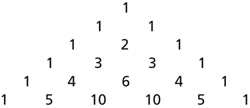A triangle of numbers in which the rth item on the nth row is the value of n−1Cr−1, the number of different combinations of (r−1) objects chosen from (n−1). The sum of the numbers on the nth row is 2n−1.

Thus 6−1C4−1=5C3=10. Apart from the 1 at the beginning and end of each row, each number is the sum of the two nearest numbers in the row above. For example 10=4+6.
The relevance of the numbers in the context of probability was noted by Pascal and the description ‘Pascal's triangle’ was first used in a book on probability by Montmort.
- time diversity
- time-division duplexing
- time-division multiple access
- time division multiplexing
- time-division multiplexing
- time division switch
- time-division switching
- time domain
- time domain reflectometer
- Time History of Events and Macroscale Interactions during Substorms
- time-homogeneous Markov chain
- time horizon
- time-inconsistency
- time lag
- time-lag argument
- time lags
- time-lapse photography
- time-of-day clock
- time of flight
- time-of-flight mass spectrometer
- time of ignition
- time of perihelion passage
- timeout
- time plane
- time preference